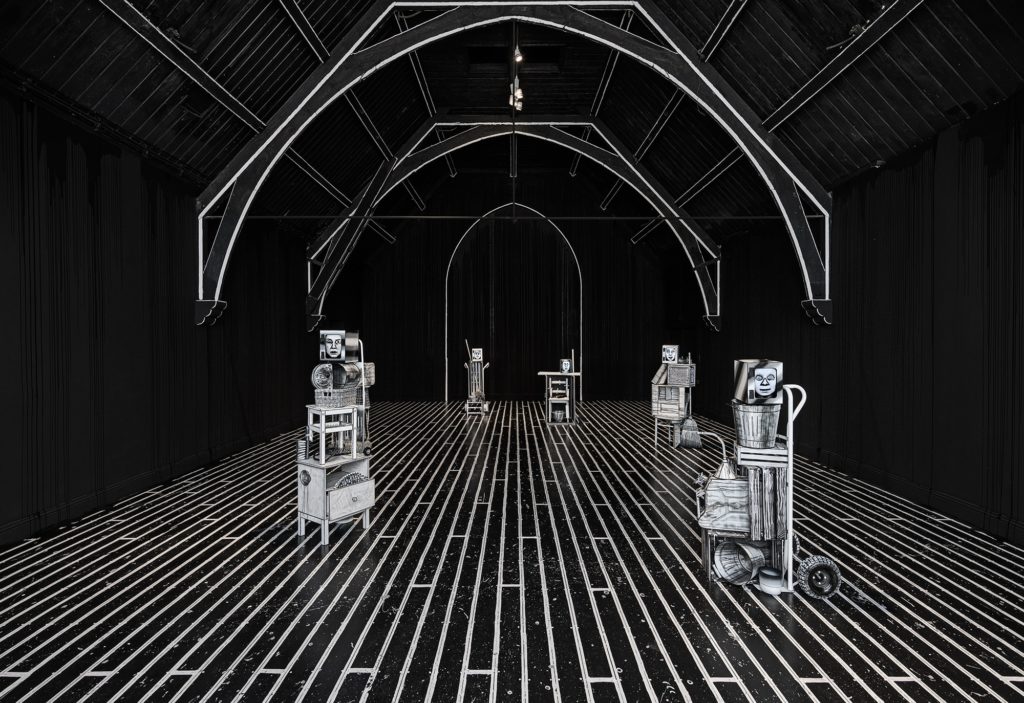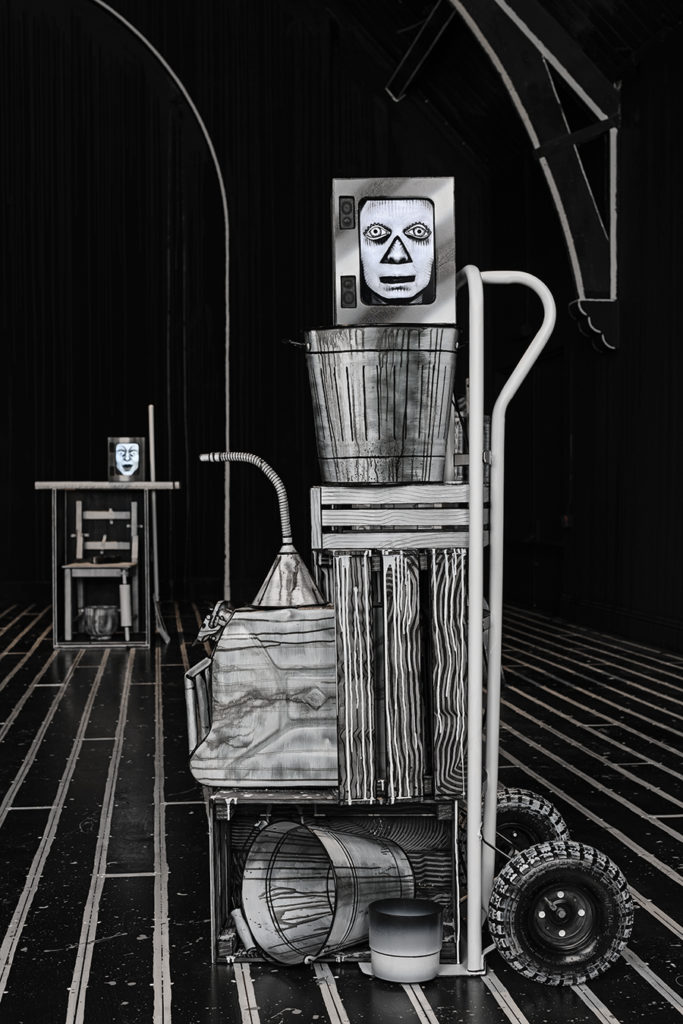Rand/Goop: Mary Reid Kelley and Patrick Kelley at Studio Voltaire
by Claire Phillips

What does a mogul of a wellness empire have in common with a philosopher best known for espousing the virtue of selfishness? Oscar-winning actress and founder of $250 million lifestyle brand Goop, Gwyneth Paltrow, is the least likely bedfellow one might expect for Russian-American writer and philosopher Ayn Rand. Yet, at their first institutional show in London, entitled Rand/Goop, American husband and wife duo Mary Reid Kelley and Patrick Kelley have brought these two women into conversation.
“What is the proper function of government/When people irritate us/ With avocado / At every successive disaster?” a shrill voice demands to know. Inside the converted Victorian chapel of Studio Voltaire’s gallery space, six towering video sculptures posit, retort, and query. The pithy lines recited by the characters onscreen (named Tiff, Paige, Nell, Liv, Cher, and Dawn) are created by splicing together the voices of Rand’s most ardent followers with the titles of articles from Goop’s website. Their faces flicker and contort. They are unstable. The results are laughable, capricious, and unsettling.
For those not au fait with her philosophy, Ayn Rand (born Alisa Zinovyevna Rosenbaum) is the leading theorist of Objectivism, which argues that “man exists for his own sake, that the pursuit of his own happiness is the highest moral purpose, that he must not sacrifice himself to others, nor sacrifice others to himself.”1 Brought to the brink of starvation and persecuted for her Jewish heritage during the Soviet revolution, Rand fled to America in 1926 and became known amongst a cult following as the author of novels The Fountainhead (1943) and Atlas Shrugged (1957). In both pieces of writing, Rand’s protagonists lionized the alpha-male capitalist entrepreneur. From fiction, Rand continued to explore the principles of Objectivism through copious articles, lectures, and courses at her own institute, the Foundation for the New Intellectual.
At the height of the Cold War in the 1980s, during the eras of Ronald Reagan and Margaret Thatcher, Rand’s brand of selfishness and laissez-faire capitalism became entwined with neoliberalism. Today, Rand has been reincarnated as the poster child for the princes of Silicon Valley and tech billionaires like Elon Musk and Peter Thiel. Despite her devout atheism, Rand has also become a valued resource for Republican Politicians such as Secretary of State Mike Pompeo and former speaker of the House of Representatives Paul Ryan, who notoriously gifted his staff copies of Atlas Shrugged each Christmas. Another, perhaps surprising, admirer of Rand is the leader of the free world himself, Donald Trump, who has described The Fountainhead as one of his favorite books.
Gwyneth Paltrow and Ayn Rand might seem incompatible, but upon closer inspection, they are perhaps cut from the same cloth. Goop was launched in 2008 when the global economy was crashing, and the sub-prime mortgage disaster was at its height. Paltrow prides herself on the brand’s aspirational, cutting-edge techniques and products, which provide a one-stop-shop to heal mind, body, and soul. Hashtag live your truth. Hashtag live your best life. While Paltrow is often the source of ridicule for new age schemes, like her infamous ‘conscious uncoupling’ from Coldplay front-man Chris Martin, Goop is frequently criticized for being elitist. Inviting its followers to wellness summits that cost upwards of $8,000 for a weekend, Goop proffers detoxes, cleanses, and sprayable elixirs to eliminate bad juju and jade eggs to regulate menstrual cycles that your average consumer could never possibly afford. Greed is good, Rand might say. In the hands of Mary Reid Kelley and Patrick Kelley, Paltrow and Rand’s mantras are removed from their context and remade into a series of double-edged puns and quick quips, complicating the meaning of each snippet and making their follies evident. Cake and cancer, soviet takeover and plant milk, body language and NATO, all somehow converge.

Language has played a vital role throughout the artist duo’s career—lifted from literature, myth, and history, and translated into contemporary syntax, words are often strewn together and set to a specific poetic rhythm with spell-like results. As with other films by the husband and wife, limits are enforced upon the language used in Rand/Goop, as speech is only in the format of a four-line cento poem: a ripped up and reconstituted “patchwork” of lines taken from different third-party sources. This tactic is recurrent in the Kelleys’ practice, as they restrict themselves to an austere palette of black and white in their sets, props, costumes, and makeup, in a way that feels timeless and dreamlike. At Studio Voltaire, the entire space of the gallery is painted from floor to ceiling, surrounding visitors in the artists’ stark aesthetic, like the color has been drained from a faulty television screen.
Feted for their ultra-stylized monochromatic films, the Kelleys’ works lie somewhere between fine art, performance, and poetry. The artists are at once burlesque and Shakespearean, comedic and tragic, ridiculous and sincere. While Patrick shoots the videos and digitally creates their backgrounds from Mary’s drawings, Mary takes the spotlight in front of the camera and transforms herself into a cast of characters that range from the terrifying Minotaur and a prostitute from World War I, to a corpse on a pathologist’s table and the drowned soldiers of the USS Sturgeon.
At Studio Voltaire, Mary’s embodiment of six different female figures is intoxicating and fearless—words filled with humor and fallacy in a way that veers between the vapid recommendations of Paltrow and the dark philosophies of Rand. Within the setting of the converted chapel, the cento poems are heard as feverish prayers or sermons delivered from the pulpit, their verses like the warnings of the three Fates: “You cannot have wealth without / Spilling the beans / On the mud floors of / Human progress.” The disjointed arrangement of words mimics a short-circuited machine—a recorded voice now garbled and perplexing. Do they believe what they say? A curious arrangement of hand-painted objects makes up the six structures within the gallery, including buckets, mops, chairs and, wicker tables. Each resembles the jumble of bric-a-brac from a child’s den, or otherwise the remnants of civilization after nuclear disaster.
Soaked in a deep understanding of the rise of wellness in the cultural zeitgeist and doctrine of Objectivism, Mary Reid Kelley and Patrick Kelley reveal their ability to quote from both the high and low brow with equal fluency. Woven together with such care, Paltrow and Rand’s words echo and ridicule one another, setting them curiously side by side in the market of vampire facials, crystal healing, and nut milk. Which is worst is left for the viewer to decide, but the artists’ distaste for both of these capitalist prophets seems unmistakable.
Mary Reid Kelley and Patrick Kelley: Rand/Goop ran at Studio Voltaire in London through October 6, 2019.